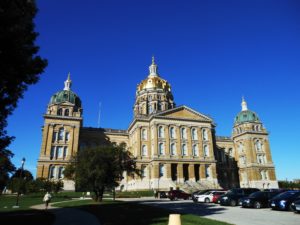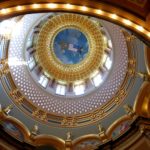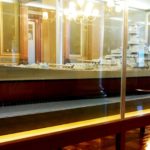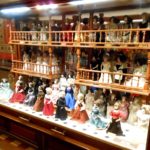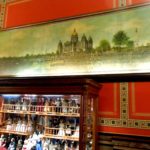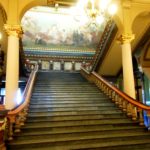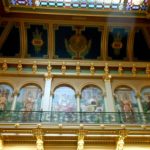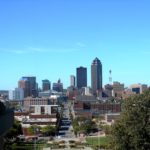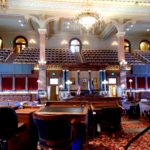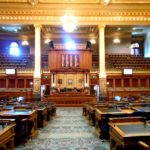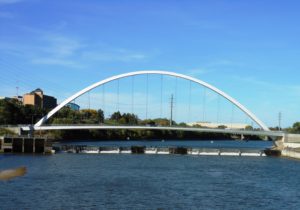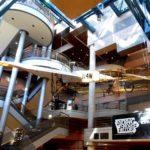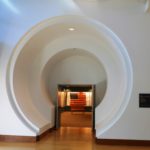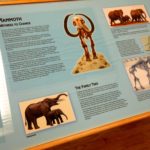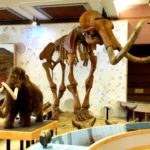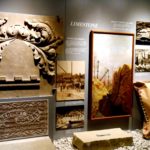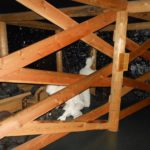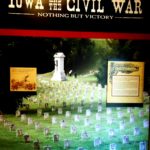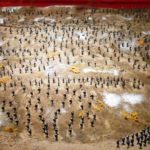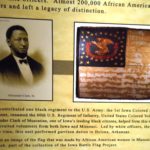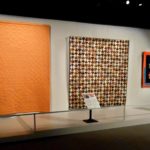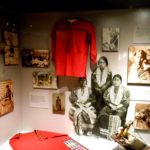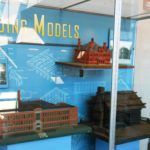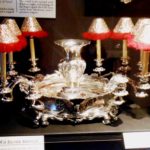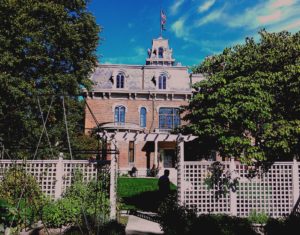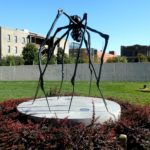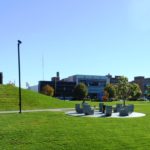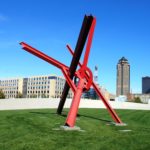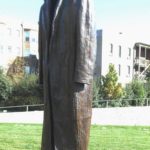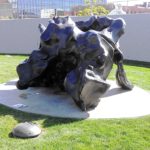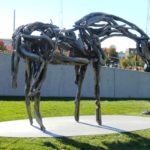We spend a couple of weeks in Iowa during The Journey, but we never made it to the Capitol. Our friends, Martha and Jim Rowland, live in Alden, about sixty miles north of the city. Alden was founded in 1855 by a Massachusetts cousin of mine, Henry Alden. We’ve been there, and we sat in the graveyard next to old Henry’s stone while the Town Historian told us the “rest of the story.”
We had a really cheap site reserved at a National Park between Des Moines and Alden – only to have the Federal shutdown cancel it. Si instead, settled for a nice site in the Des Moines Fairgrounds and made a date to meet Martha and Jim at a locally famous eatery, The Hickory Park Restaurant in Ames — which is also the home of the University of Iowa.
We set out to see as much of the City’s sights as we could in the remaining time. The list was a dozen items long, and we did less than half of it. So there’s good reason to come back.
Our first stop was The Capitol. You’ll not be surprised to learn that it has a dome, a rotunda, a grand staircase, governor’s suite, law library, old Supreme Court quarters, and both Senate and House chambers! The dome is covered with gold leaf and was re-gilded in 1998-99. The leaf is so thin that 250,000 sheets would measure only one inch thick. Construction was started in 1871, but it wasn’t completed until 1886. Unlike most Capitols we’ve visited, no additions have been required, and except for the ceiling of the House Chamber, redone after a fire in 1904, everything is original.
We had an excellent tour guide and a large contingent, most of which was a high-school class from Russia. Nice kids. After visiting the Governor’s Reception Room, we were introduced to a doll collection that consists of all the State’s first ladies in their inauguration gowns. Above it is a reproduction photograph showing a division returning home from W.W. I. At 26 feet x 6 feet, it’s one of the largest in the world. Additional artifacts on this level are an 18 foot long, scale model of the U.S.S. Iowa and the original of Iowa’s Constitution, restored and preserved in 1988. Not present was a collection of 140 Civil War battle flags, currently offsite and being stabilized by the State Historical Museum.
- Exterior of the gilded Dome
- Interior of the Dome
- 18 foot long model of the U.S.S. Iowa
- Collection of First Lady Dolls
- The 26 foot photo of W.W. I troops coming home.
- The Russian High School Class
Climbing the Grand Stairway, art abounds. A wall sized painting, Westward, depicts the arrival of pioneers in Iowa. Above it, on the balcony, are a set of six mosaics, designed by Frederick Dielman of New York and made in Venice of small colored stones. They depict the functions of government: Defense, Charities, Executive, Legislative, Judiciary and Education. Opposite the stairway is the Law Library, with unique iron spiral stairways to access its multiple levels with matching balconies. The south wing belongs to the 50 state senators. Both they and the 100 representatives are citizen legislators, spending just over three months in session and pursuing other occupations for the rest of the year. Both chambers are elegantly fitted but less decorative than some we’ve seen.
- The Grand Staircase and “Westward”
- The Mosaics — see story above
- The Library — details above
- View from the Library
- Senate Chamber
- House Chamber
Below the dome, a series of 8 half-moon paintings and 12 statues represent the values and tools of civilization: herding, agriculture, the forge, commerce, education, science, art, history, law, literature, fame, industry, peace, victory, truth and progress. At the top of the dome is the Grand Army of the Republic symbol, heralding the efforts of Iowa to preserve the Union during the Civil War. We were invited to hike the additional dozens of narrow steps up into the dome; while the kids were eager to do so, we passed.
With the Des Moines River bisecting the city, there are dozens of bridges that cross it. Of special significance is the Principal Riverwalk, a 1.2 mile section in the heart of the city sponsored by the Principal Finance Group on its 125 anniversary of its tenure in the city. The Riverwalk consists of six riverside attractions and two pedestrian/bicycle bridges. There are two promenades with trails, a skating rink, a garden and a sculpture park. The Hub Spot, still underway, will be a place to meet, stroll and eat. The bridge at the south end is a renovation of the old Union Railroad Bridge — now known as the “Red Bridge” because of its caboose-toned paint job — with separate lanes for walkers and bike riders. The bridge at the north end honors The Women of Achievement in Iowa and, likewise, splits into separate lanes for walkers and riders.. Four women are currently named, and several will be added each year via citizen recommendations.
The State Historical Museum was worth a full day. Exhibits include Native Americans, Prehistoric heritage, wildlife, industry, military, natural resources, and the environment Specific exhibits include quilts (a study of restoration methods by type of material), the art of model making, and the custom silver service aboard the original U.S.S. Iowa. Iowa takes great pride in its contribution to Sherman’s March through Vicksburg and across the south, as well as the regiment of African Americans from the state who served the Union.
- Museum Lobby
- Entrance to the History Resource Center
- At The Close of the Ice Age
- Woolly Mamoths
- The Limestone Industry
- Coal Miners at Work
- A Family of Natural Predators
- Civil War Cemetery
- The Battle of Shiloh recounted
- Diorama of the Battle of Ft. Donalson
- Alexander Clark, Sr. and the Black Regiment
- Part of the Quilt Exhibit and Study
- Early Family
- Interesting Sauk and Fox History
- Part of a major exhibit of Model Making
- Silver Service from the original U.S.S. Iowa
The Governor’s Mansion is open for three tours a day, 5 days a week except in December. The third floor, part of the second and the basement are used by the incumbent governor and his family. Our tour began with a talk in – what else – the former Carriage House! Pictures weren’t allowed anywhere inside, but our guide was passionate about the place and held our interest with his thorough knowledge of its structure, its contents and its residents.
The home was originally built by Iowa’s first millionaire, Benjamin Franklin Allen, in 1869. It was purchased from the bankrupt Allen in 1884 by Frederick Marion Hubbell, who named it Terrace Hill. Hubbell came to Des Moines with his father in 1855. His father went back to Connecticut several years later, but Frederick decided to stay. In the ensuing years, he became the richest man in Iowa, and others in his family prospered as well.
From 1846 until 1947, only one governor spent his four years in supplied housing. In 1947, Iowa bought a colonial-style home for its governors. The Hubbells donated Terrace Hill to the state in 1970. and in 1977, the first “First Family” took up residence there.
The most exceptional exhibit in town was the John and Mary Pappajohn Sculpture Park. No, there’s no connection to the pizza giant! John traveled from Greece to America at the age of 6 months, lost his father at age 16, and, along with his brothers, had to alternate school with working to support the family. After graduating from U-Iowa, he opened an insurance agency and climbed the entrepreneurial ladder up to Pappajohn Capital Resources. He and his wife Mary have donated over $100 million, mostly to education and artistic endeavors. One of those endowments is the delightful park that occupies 4.4 acres from 13th to 15th Street on the west side. The Pappajohns donated 27 sculptures, valued at over $40 million, and the city built the environment and maintains the exhibit. A comprehensive brochure is available on site, detailing each work and even providing activities for children. Many of the artists are American or British, but there’s also an international representation. Some artists are as famous as Willem de Kooning. I will let the statuary speak for itself.
- SPIDER, Louise Bourgeois, Bronze, 1997
- THINKER ON A ROCK, Barry Flanagan, Bronze, 1997
- BACK OF A SNOWMAN (white and black), Gary Hume, Enameled Bronze, 2002
- SEATING FOR 8, Scott Burton, Granite, 1990
- WHITE GHOST, Yoshitomo Nara, Fiberglass, 2010
- T 8, Mark di Suvero, Painted Steel, 1987
- THREE DANCING FIGURES VERSION C, Keith Haring, Painted Aluminum, 1989
- NOMADE (27 feet tall), Jaume Plensa, Painted Steel, 2007
- POST BALZAC, Judith Shea, Bronze and Stone, 1990
- RECLINING FIGURE, Willem de Kooning, Bronze, 1989
- MARRIAGE, Tony Smith, Painted Steel, 1961
- ANCIENT FOREST, Deborah Butterfield, Bronze, 1989
Our reunion with Martha and Jim was wonderful. The Hickory Park Restaurant is a kitschy place that specializes in barbecue and ice cream, serving giant sized portions of everything. We made an afternoon of it, knowing it might be a long time before we saw each other again.

